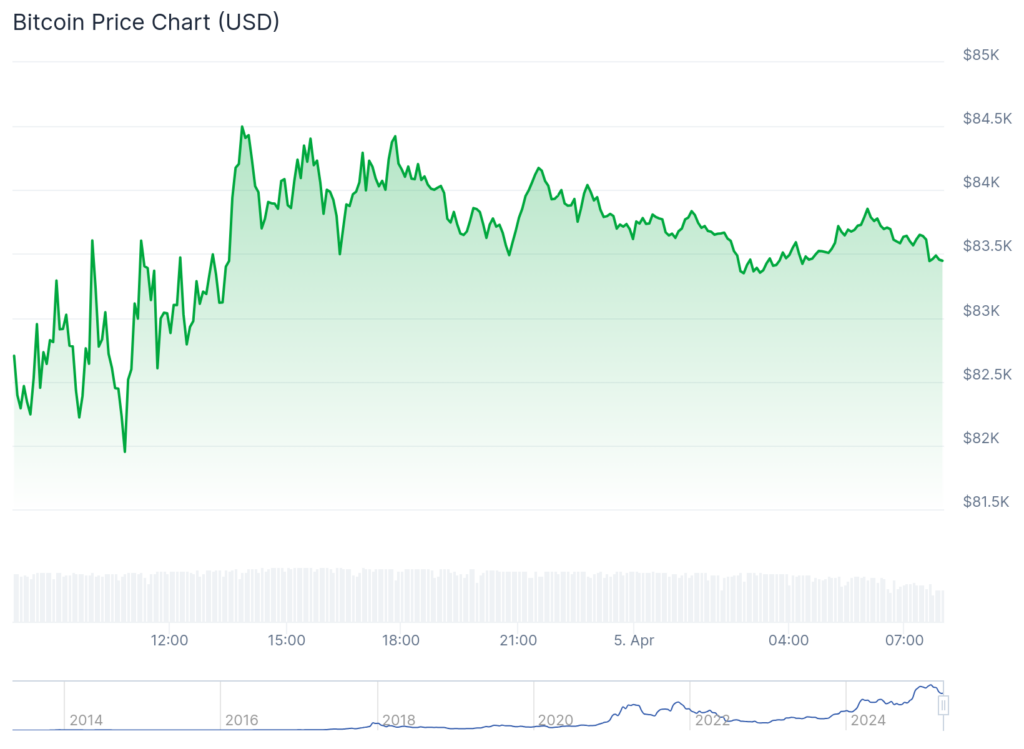Following Donald Trump’s announcement regarding his Liberation Day tariffs, Bitcoin and a majority of altcoins outperformed traditional stocks.
Bitcoin (BTC) remained in the range of $80,000 to $90,000, whereas Ethereum (ETH) lingered just below $2,000. The overall market capitalization of cryptocurrencies decreased from $2.7 trillion to $2.6 trillion.
In contrast, the stock market experienced its worst week since 2020, with the prominent Nasdaq 100, S&P 500, and Dow Jones indices all falling into correction territory.
Alarming Fed Signals on Stagflation
Bitcoin and altcoins may face increased pressure after Fed Chairman Jerome Powell cautioned that Trump’s tariffs could lead to heightened inflation and stagnating growth for the U.S. economy.
“Our responsibility is to maintain long-term inflation expectations and ensure that a temporary rise in prices does not evolve into persistent inflation issues,” Powell stated on Friday.
High inflation paired with significant unemployment risks stagflation, a challenging economic condition. Efforts to resolve one issue—such as lowering interest rates to stimulate growth—can inadvertently exacerbate another issue, like inflation, and vice versa.
Powell emphasized he was in no rush to lower interest rates due to ongoing high inflation levels, a sentiment echoed by other officials such as Raphael Bostic and Adriana Kugler, who have advocated for maintaining elevated rates to combat inflation.
On the other hand, Trump disagrees.
“This would be a PERFECT opportunity for Fed Chairman Jerome Powell to lower interest rates,” Trump posted on his social media platform, accusing Powell of engaging in “political maneuvering.”
The Fed’s Board of Governors operates as an independent government entity.
Experts note that a more hawkish Fed, particularly while analysts predict a recession, could adversely affect Bitcoin, altcoins, and stock prices. Historically, such assets tend to perform well during periods of interest rate cuts by the Fed.
As of the latest update, Bitcoin was trading at approximately $83,435. See below.

Bond Market and Oil Prices Provide Some Relief
On a brighter note, leading indicators suggest that the Federal Reserve may consider cutting interest rates sooner than expected.
In recent days, crude oil prices have plummeted, with Brent crude, the global standard, dropping to $64 on Friday. West Texas Intermediate fell to $62.
Additionally, copper—often viewed as an economic indicator—has also experienced sharp declines. Such trends point toward a possible recession as demand from consumers and businesses decreases.
Similar messages are coming from the bond market, with the 10-year and 2-year yields falling to 3.95% and 3.5%, respectively.
These indications suggest a potentially dovish stance from the Fed, paving the way for interest rate cuts in the near future. Earlier this week, Goldman Sachs increased the likelihood of a U.S. recession and forecasted that the Fed would implement at least three rate reductions later this year.
History has shown that riskier assets such as stocks, Bitcoin, and altcoins tend to thrive when the Fed lowers rates. For instance, all of these surged in 2020 after the Fed initiated an emergency rate cut due to the pandemic, and stocks witnessed a decade-long growth period following the Fed’s rate slashes during the Global Financial Crisis.
